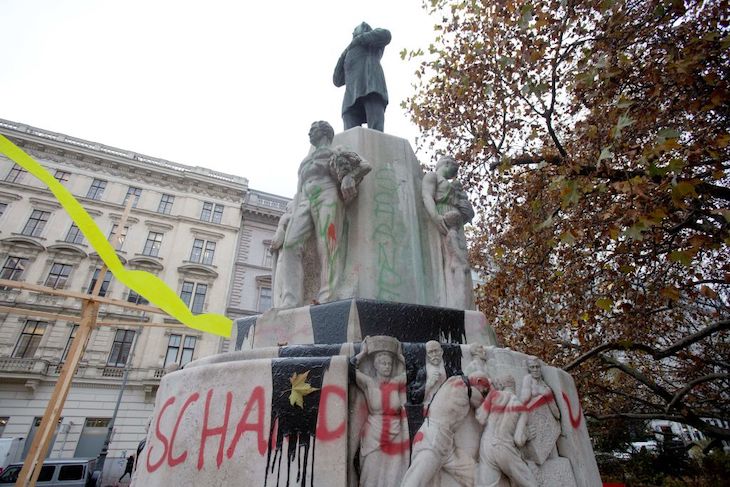Tilting a statue. That’s the solution now. At least, that’s what a jury appointed by Vienna city council has recommended as the best way to deal with a controversial likeness of Karl Lueger, the early 20th-century mayor who shaped the modern city, but also happened to be an antisemite.
Dr Lueger was a social reformer, changing the face of Vienna with new hospitals, schools and state-owned abattoirs, as well as better water, gas and electricity infrastructure, transport systems, a green belt and a distinctive architectural aesthetic. But he was also an ultra-conservative Catholic populist, who regularly indulged in Jew-baiting.
He can be judged by his fans. In Mein Kampf, Hitler chillingly admired Lueger’s talent for ‘fostering the militant spirit in (supporters) rather than attempting to paralyse it’. It is true that the mayor’s antisemitism was too milquetoast for the future Führer, who derided it as ‘an apparent antisemitism that was almost worse than none’; but Hitler had exacting standards, and an antisemite Lueger was, to the modern sensibility at least.
Tearing statues down is the coward’s way out
Which is why his statue – which over the years has been denounced by Holocaust survivors, defaced, concealed and mocked – is to be tilted. The idea, proposed by an art student, is intended to bestow upon the observer a sense of disorientation, being the angle at which the aberration is picked up by the human eye. Surely this is an interesting piece of disruption, intended as a compromise between leaving the statue alone and toppling it. But in my view, it is no solution to the problem of unfashionable street furniture.
Whether that problem even exists is a question. Seen through modern eyes, the pomposity of the statue of Mayor Lueger is surely no longer a mark of esteem, but a rebuke to the city’s dark past. Imagine a man who has beaten his wife being forced to look at a photograph of her battered face daily. The vainglorious monument to Lueger is that photograph. Its presence can only remind Vienna of the way it put antisemites on pedestals in living memory, and asks questions about the bigotry that remains widespread in Austrian culture in 2023.
The memorials that crowd Britain’s cities, including the erstwhile statue of slaver and philanthropist Edward Colston in Bristol and the depiction of Cecil Rhodes in Oxford, should be viewed in a similar light. The fact that they were erected in the spirit of adulation does not mean that they hold the same significance today. Those who know the history of these figures will recall them in all their complexity, without glossing over their sins, and understand – alongside their achievements – the parts they played in the darkness of our collective history.
Aha, I hear you cry, but most people don’t have the foggiest who these people were. So, I reply, what are you worried about, then? Isn’t that the ultimate triumph? George Eliot wrote, ‘our dead are never dead to us until we have forgotten them’. Well, to the vast majority of Britons and Austrians, for better or for worse, men like Cecil Rhodes, Edward Colston and Karl Lueger are truly dead.
In fact, it is those seeking to topple them who are keeping them alive. The statue of Rhodes outside Oriel College is well known only because of those who are outraged by it. Otherwise he’d just be some guy, known only to history dweebs and tour guides. Other ‘problematic’ plaques and reliefs in Oxford have been covered up, attracting more attention than they ever had in the first place. The oxygen of offence is being breathed into the corpses of these ‘dead, white men’, reanimating them in the public consciousness. Surely, if you want to be rid of them, far better to stop with the puffing?
Tearing statues down is the coward’s way out. It allows us to walk the streets of our cities without being reminded of the sins that were involved in their building, and without acknowledging their dark legacy all around us. It denies the shadow side of that contract between the dead, the living and the unborn. Those advocating the toppling of statues must answer this: is it not braver to put up with the discomfort of looking into those stone eyes, searching for answers to the questions they hold?
Which brings me to the tilt. This art student’s modern mockery undermines the honour with which the statue of Lueger was erected in 1926; in doing so, it makes the bitter pill of Austria’s past easier to swallow. After all, it’s much more pleasant to congratulate ourselves for making the bigotry of the past absurd than to ask how it happened in the first place, or to wonder why those same prejudices remain dominant in society today.
In April, an official study found that a third of Austrians believed that Jews ‘dominate international business’, were exerting growing ‘power and influence’ over politics and media, and were seeking to ‘take advantage’ of the Holocaust for their own ends. One fifth, meanwhile, said they thought Jews were at least ‘partly responsible’ for their own persecution. Ain’t no tilt you can put on that.







Comments